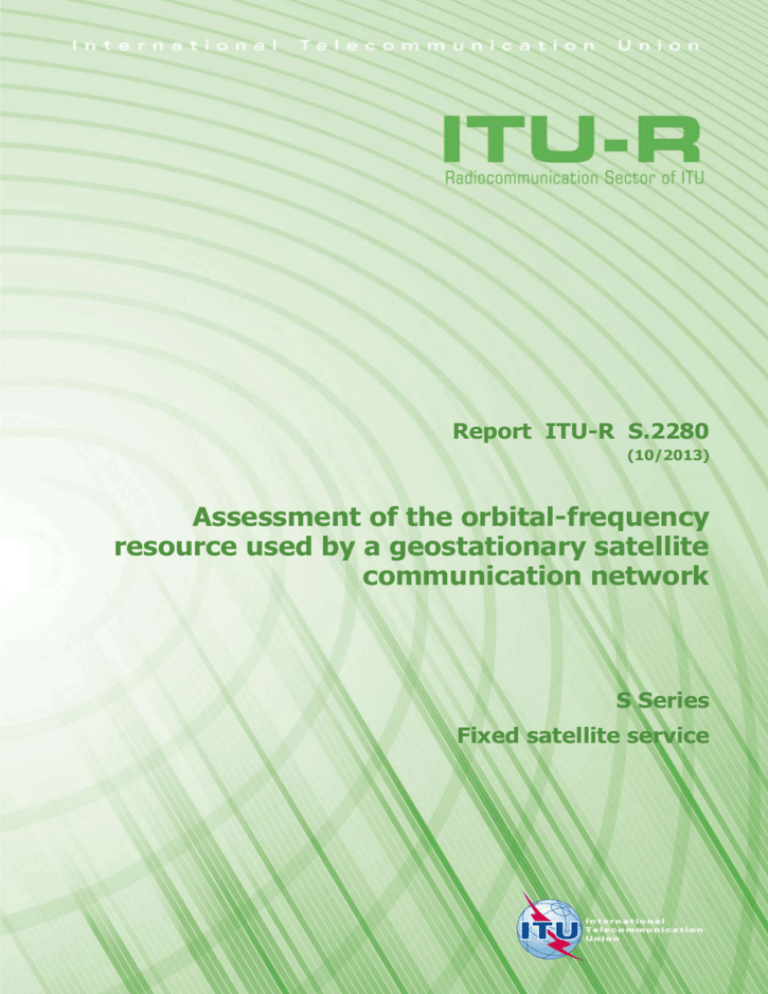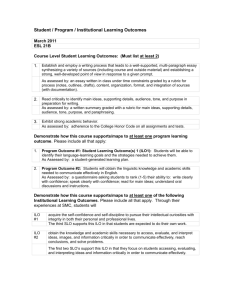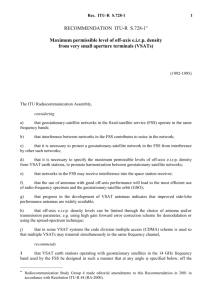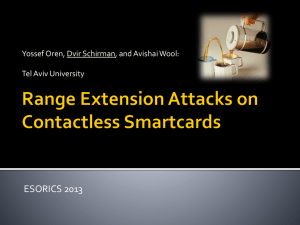
Report ITU-R S.2280
(10/2013)
Assessment of the orbital-frequency
resource used by a geostationary satellite
communication network
S Series
Fixed satellite service
ii
Rep. ITU-R S.2280
Foreword
The role of the Radiocommunication Sector is to ensure the rational, equitable, efficient and economical use of the
radio-frequency spectrum by all radiocommunication services, including satellite services, and carry out studies without
limit of frequency range on the basis of which Recommendations are adopted.
The regulatory and policy functions of the Radiocommunication Sector are performed by World and Regional
Radiocommunication Conferences and Radiocommunication Assemblies supported by Study Groups.
Policy on Intellectual Property Right (IPR)
ITU-R policy on IPR is described in the Common Patent Policy for ITU-T/ITU-R/ISO/IEC referenced in Annex 1 of
Resolution ITU-R 1. Forms to be used for the submission of patent statements and licensing declarations by patent
holders are available from http://www.itu.int/ITU-R/go/patents/en where the Guidelines for Implementation of the
Common Patent Policy for ITU-T/ITU-R/ISO/IEC and the ITU-R patent information database can also be found.
Series of ITU-R Reports
(Also available online at http://www.itu.int/publ/R-REP/en)
Series
BO
BR
BS
BT
F
M
P
RA
RS
S
SA
SF
SM
Title
Satellite delivery
Recording for production, archival and play-out; film for television
Broadcasting service (sound)
Broadcasting service (television)
Fixed service
Mobile, radiodetermination, amateur and related satellite services
Radiowave propagation
Radio astronomy
Remote sensing systems
Fixed-satellite service
Space applications and meteorology
Frequency sharing and coordination between fixed-satellite and fixed service systems
Spectrum management
Note: This ITU-R Report was approved in English by the Study Group under the procedure detailed in
Resolution ITU-R 1.
Electronic Publication
Geneva, 2013
ITU 2013
All rights reserved. No part of this publication may be reproduced, by any means whatsoever, without written permission of ITU.
Rep. ITU-R S.2280
1
REPORT ITU-R S.2280
Assessment of the orbital-frequency resource used by a
geostationary satellite communication network
(2013)
TABLE OF CONTENTS
Page
1
Introduction ....................................................................................................................
2
2
Measurement unit ...........................................................................................................
2
3
Assessment of the occupied orbital arc ..........................................................................
2
4
Generalized parameters of the reference system ............................................................
4
5
Interference sensitivity of the assessed network.............................................................
4
6
Final evaluation of the occupied orbital arc and of the occupied orbital-frequency
resource ...........................................................................................................................
5
Conclusion ......................................................................................................................
5
Annex 1 – List of abbreviations and notations, and main relationships between used values
7
Annex 2 – Example of reference network parameters .............................................................
8
Annex 3 – The effect of network parameters on the occupied orbital-frequency resource .....
9
7
2
1
Rep. ITU-R S.2280
Introduction
The congestion in the geostationary-satellite orbit (GSO) experienced by FSS and BSS networks is
well-known and results from natural constraints of the angular dimension of the unique GSO
(360 degrees) and limited frequency bands allocated to satellite communications.
Numerous studies, including those carried out in the framework of ITU-R Study Group 4, have
been aimed at increasing the total GSO resource and its efficient use. However, no methodology for
evaluation of the resource occupied by a given geostationary satellite network, which could make it
possible to compare networks of the same service using a common metric, has been discussed or
approved in the framework of the ITU. This Report provides a methodology that could be used to
arrive at a metric that would represent the amount of orbital-frequency resource (OFR) occupied by
a given GSO satellite network.
The intent of this methodology is to make the assessment of the occupied resource as simple and
practicable as possible, in order to allow for comparative evaluation of different GSO networks.
2
Measurement unit
The GSO OFR, occupied by a given FSS or BSS network (OOFR), is considered to be the part of
the overall OFR of the GSO which cannot be used by other FSS or BSS networks.
The OOFR of a satellite communication or broadcasting network is directly proportional to two
components – the occupied bandwidth, ΔF (Hz), and the occupied GSO arc, Δφ (degrees), of the
network under consideration. For example, the number of similar networks which can be located
within the whole GSO equals (360/Δφ)·(Δf/ΔF), where Δf is the bandwidth allocated to the service.
The size of the OOFR is defined as:
R = ΔF·Δφ·k, (Hzdegr.)
(1)
where:
k=1
k = 0.5
if the assessed system uses polarization division and both polarizations (or no
polarization division); and
if only one polarization is used, but polarization division is foreseen and
allowed.
Given this definition of OOFR, the measuring unit is hertzdegree (Hzdegr.).
The occupied bandwidth as defined by the Radio Regulations is the width of a frequency band
where the major part of the total mean power of a given emission is located (RR No. 1.153). The
methodology contained in this Report does not consider the case of several
co-located/co-frequency/co-coverage FSS or BSS networks (e.g. wave-form division or CDMA is
not considered), so it is supposed that any network at a given notified orbital position occupies the
whole notified frequency band irrespective of the pfd level and signal-to-noise ratio.
The term “occupied orbital arc” is considered as the part of the GSO on both sides of the satellite
position of the assessed network, which cannot be used for deployment of satellites of other
networks because of harmful interference between networks.
3
Assessment of the occupied orbital arc
For already operating networks, the minimum angular separation, Δφ, Δφ+, between the assessed
network and the nearest adjacent GSO networks operating in the same frequency band can be
determined using the current criteria, and it is possible to assume that the assessed network occupies
the arc Δφ = [(Δφ)+(Δφ+)]/2.
Rep. ITU-R S.2280
3
For networks which requested coordination at a given orbital position, the necessary angular
separation from submitted or notified adjacent networks, for which the interference level does not
exceed permissible limits, could be also defined.
However, it is evident that such assessment is not appropriate for the comparison of the networks
because the result will be random, depending on adjacent network parameters such as emitted
power, sensitivity to interference, size and location of coverage areas, ES antenna size and so on
and, finally, on the number of networks on the given GSO arc. It is also evident that such evaluation
is not applicable to assess networks which are prepared for application if their orbital positions have
not been determined yet.
An approach [1], [2] provides the description of a method for evaluation of the occupied orbital arc
by the necessary angular separation from an adjacent network having exactly the same parameters
as the assessed network. The non-applicability of this approach is evident; if, for example, the
network under assessment has high emitted power, it will consequently cause high interference to
less powerful networks, but this approach will show their compatibility in relation to similar
networks at a small angular separation.
Relying on these considerations, it is proposed to accept a method for determining the occupied
orbital arc by the value of the necessary angular separation with regard to a reference network,
applied to assess the occupied orbital arc for all networks in the framework of a certain service and
frequency band (see Fig. 1). Parameters of the reference network should be chosen on the basis of
operating systems, i.e. they should be typical and representative for networks in a certain radio
service and a certain frequency band. This approach will put all assessed networks into equal
conditions, and in addition this will facilitate the homogeneity of the networks, which will benefit to
increased capacity of the GSO.
In equation (1) above, it is assumed that the service areas of the assessed and reference networks
overlap, and earth stations are located within the overlapped part of these service areas. These
assumptions significantly simplify calculations and correspond to the most difficult and practically
the most frequent case. In this case, the coverage area of the assessed system is not taken into
consideration.
However, if an ideal radiation pattern (i.e. zero gain of the satellite antenna outside the coverage
area) is assumed for both the assessed and reference systems, then the assessed system coverage
area may be taken into consideration while assessing the occupied resource by introducing a simple
coefficient s = Sc/Ss, which represents the ratio of the covered territory Sc to the whole visible
Earth’s surface Ss, because, evidently, the part of the Earth’s surface not being a part of the
coverage area of the assessed network is free from interference in this ideal case and the necessary
angular separation between satellites equals zero when an earth station of the reference system is
located outside the coverage area of the assessed system. In order to account for this geographic
coverage aspect of the assessed system, the factor shown in (2) below is added to (1):
s = Sc/Ss
(2)
In other words, the surface area (Ss – Sc) can be used by other networks without any angular
separation between satellites. Assessment of an interference-free area can be obtained without the
presumption of an ideal radiation pattern of the assessed satellite network while determining the
value of Sc and (Ss – Sc) using pfded, pfdeup, pfdrid and pfdriup, pfdrd, pfdrup, pfdeid, pfdeiup values and
active compatibility criteria (see their definitions and relationships in Annex 1).
On this basis, the following equation is used for the calculation of the occupied resource rather than
(1):
R = ΔF·Δφ·k·s, (Hzdegr.)
(3)
4
Rep. ITU-R S.2280
where Δφ is the required angular separation of the assessed network relative to the reference
network; other values being as defined above.
4
Generalized parameters of the reference system
Parameters of an FSS network in the 6/4 GHz and 14/11 GHz bands were proposed to specify pfd
coordination levels on the Earth’s surface and at the GSO in order to fully protect satellite networks
outside the coordination arc earlier in ITU-R in preparations for previous WRC, and appear to be
appropriate for a reference FSS network for interference assessment towards the reference network
(RN) as it was stated in the specified documents (see Annex 2). Parameters of a typical BSS
network in the 21.4-22.0 GHz band are specified in Annex 1 to Resolution 553 (WRC-12).
Based on the technical parameters of the reference network specified in Annex 2, one can determine
generalized parameters of the reference network sufficient to analyse interference caused to the
reference network by the network under assessment:
–
interference power-flux density, pfdriup, acceptable for a reference network in the uplink
(at the GSO);
–
interference power-flux density, pfdrid, acceptable for a reference network in the downlink
(at the Earth’s surface), which depends on the diameter of the earth station antenna and
angular separation between satellites of the assessed and reference networks.
The necessary angular separation in the downlink, rd, is derived directly from Fig. 2
(FSS network in the Ku-band or similar in other cases), by finding a point on the envelope
corresponding to a maximum permissible pfd created by the satellite of the assessed network at the
Earth’s surface.
The necessary angular separation in the uplink, rup, is determined by the value of angular
separation under which the pfd at the GSO from all types of ESs in the network under assessment,
taking into account their e.i.r.p. and selectivity of the antenna, does not exceed the value of pfdriup
given above.
To describe the effect of interference to the network under assessment (specifically for the
calculation of the occupied orbital arc using the acceptable level of interference to the network
under assessment) it is necessary to complement the above parameters of the reference network
with values defining pfd of the wanted signal of the reference network in the uplink and downlink,
pfdrd and pfdrup. For that, it is sufficient to choose a typical signal-to-noise ratio in the uplink and
downlink, C/N, for the reference network.
5
Interference sensitivity of the assessed network
To define interference sensitivity of the assessed network, it is necessary to have the network
parameters similar to those shown above for the calculation of interference to the reference
network. In the generalized form, it is the permissible interference in the uplink, pfdeiup, for the
assessed network (minimum value for the whole set of signal types transmitted in this network) and
the permissible interference in the downlink, pfdeid, with the value of the latter depending on the
size and radiation pattern of ES antennas of the assessed network, as well as on angular separation.
The value of the necessary angular separation in the downlink is determined by the value of ed at
which the pfd produced by the reference network equals the permissible pfdeid value for the assessed
network (minimum value for all notified antenna types), and the necessary angular separation in the
uplink is determined by the value of eup at which the pfd produced by the reference network
equals pfdeiup (also minimum value). The value of eup is determined by the necessary selectivity
Rep. ITU-R S.2280
5
of the reference network ES antenna. If the reference network allows different sizes of ES antennas,
it may be convenient for assessment to plot curves similar to Fig. 2.
6
Final evaluation of the occupied orbital arc and of the occupied orbital-frequency
resource
The final evaluation of the occupied orbital arc shall use the maximum value of four derived values:
Δφ= max[Δφrup, Δφeup, Δφrd, Δφed]
(4)
Then, taking all the above into account and the number of satellites in the network, N, the final
evaluation of the orbital-frequency resource occupied by the network is:
N
R ( F k s )n
(5)
n 1
7
Conclusion
The assessment of the orbital-frequency resource used by the network deems necessary to compare
systems with regard to their use of the outer space resource. It can also be used to assess the
resource necessary for administrations to meet national or regional needs. In the latter case, the
number N of GSO positions is determined by the minimum angle of arrival necessary to cover the
territory of a country/group of countries. When assessing the required national/regional resource,
other factors could also be taken into account determining the necessary use of satellite
communication systems [4].
The condition of using the proposed method for assessment of the occupied OFR is the
development and approval of reference network parameters for different services and frequency
bands, and for this there may be a sufficient basis taking into account previously submitted ITU-R
documentation.
6
Rep. ITU-R S.2280
FIGURE 1
RSSS – space station of reference system
RSES – earth station of reference system
SS1 – space station of the assessed system
ES1 – earth station of the assessed system
FIGURE 2
Acceptable downlink pfd for the u-band reference system
-170
downlink pfd limit to meet dT/T = 6%
-180
pfd (dB(W/(m^2 Hz)))
-190
0.45 m
-200
0.6 m
0.9 m
1.8 m
-210
3.5 m
11 m
Method C3 prospective pfd mask
-220
Method C2 prospective pfd limit
-230
-240
0,01
0,1
1
10
100
Geocentric separation (degrees)
NOTE – Geocentric separation angle corresponding to pfd value equal to or more than
–181 dB(W/m2·Hz) is defined by the brown line (i.e. curve for 11 m antenna) for the purpose of this
Report.
Rep. ITU-R S.2280
7
References
[1]
Спутниковая связь и проблема геостационарной орбиты. Кантор Л.Я, Тимофеев В.В. Радио и
связь, 1988г.
(Satellite communications and the problem of the geostationary orbit. L. Kantor, V. Timofeev,
Radio-i-svyaz Publishers, 1988.)
[2]
CC1R. XV-th Plenary Assembly. Vol. IV1. Geneva: ITU, 1982. 501 P.
[3]
WRC-12 Final Acts. Resolution 756 (WRC-12).
[4]
G. Chouinard. Bringing broadband access to rural and remote areas. ITU News, April 2006.
Annex 1
List of abbreviations and notations, and main relationships between used values
pfdrd – pfd of the wanted signal of reference network in the downlink
pfdrup wanted signal pfd of reference network in the uplink
pfded – wanted signal pfd of assessed network in the downlink
pfdeup – wanted signal pfd of assessed network in the uplink
pfdrid acceptable interference pfd towards reference network (min) in the downlink
pfdriup acceptable interference pfd towards reference network (min) in the uplink
pfdeid acceptable interference pfd towards assessed network (min) in the downlink
pfdeiup acceptable interference pfd towards the assessed network (min.) in the uplink
Serd – spatial selectivity of a reference network ES antenna in the downlink
Serup – spatial selectivity of reference network ES antenna in the uplink
Seed – spatial selectivity of assessed network ES antenna in the downlink
Seeup – spatial selectivity of assessed network ES antenna in the uplink
ES – Earth station
RN – Reference network
EN – Assessed network
Δφ – necessary angular separation between EN and RN
Δφrd – necessary angular separation between EN and RN due to pfdrid and pfded
Δφrup – necessary angular separation between EN and RN due to pfdriup and pfdeup
Δφed – necessary angular separation between EN and RN due to pfdeid and pfdrd
Δφeup – necessary angular separation between EN and RN due to pfdeiup and pfdrup
8
Rep. ITU-R S.2280
s = Sc/Ss relative coverage area of the assessed network
Sc – coverage area of the assessed network
Ss – Earth surface area visible from the GSO position
C/N, С/I, N/I – required signal-to-noise ratio, signal-to-single entry interference ratio,
noise-to-interference ratio in the uplink (up) and the downlink (d) for the assessed network (e) and
for the reference network (r).
RELATIONSHIPS BETWEEN USED VALUES
pfdeid = pfdrd Seed(Δφed) = pfded – (C/I)ed = pfded (C/N)ed – (N/I)ed
pfdeiup = pfdrup – Serup(Δφrup) = pfdeup (C/I)eup = pfdeup – (С/N)eup (N/I)eup
pfdrid = pfded – Serd(Δφrd) = pfdrd (C/I)rd = pfdrd – (С/N)rd (N/I)rd
pfdriup = pfdeup – Seeup(Δφeup) = pfdrup (C/I)eup = pfdrup – (С/N)rup (N/I)rup
Annex 2
Example of reference network parameters
The following technical parameters are proposed for FSS networks in the 14/11 GHz band for
illustrative purposes:
–
criterion for acceptable single entry interference from any other FSS network ΔТ/Т = 6%
(12.2 dB);
–
ES noise temperature = 125 K;
–
satellite G/T = 8 dB/K; ES antenna diameter Da = 0.45 m, 0.6 m, 0.9 m, 1.8 m, 3.5 m, 11 m;
downlink frequency is 11 GHz, uplink frequency is 14 GHz;
–
ES antenna pattern complies with Recommendations ITU-R S.580-6, ITU-R S.465, and
BR Antenna Pattern Library (APL);
–
circular and linear polarization, for both uplink and downlink.
On the basis of these certain technical parameters, generalized parameters can be determined which
would simplify the calculations:
–
pfdriup = 205 dB (W/m2·Hz);
–
pfdrid shown in Fig. 2.
For the assessment of interference towards the assessed network it is necessary to evaluate the pfd
of the reference network signals in the uplink and downlink. Thus, assuming that under the clear
weather conditions this value is the same for both uplink and downlink and equals to C/N = 14 dB,
then the pfd on the Earth’s surface is equal to pfdrd = 184.12 dB (W/m2·Hz) for the minimum
value of ES antenna diameter 0.45 m (in this case the e.i.r.p. of a reference network satellite is equal
to 56 dBW in 36 MHz):
Rep. ITU-R S.2280
–
9
towards the GSO (to the position of the reference network satellite), pfdrup = 178.2 dB
(W/m2·Hz) from any reference network ES.
An example of assessment of the occupied orbital-frequency resource based on these parameters:
If the assessed FSS network in the Ku-band has the same generalized parameters as the reference
network, global coverage and dual polarization, then the occupied GSO arc will be 6.7° (for ES
antenna diameter 45 cm); and if the occupied frequency band is 500 MHz, then
R = 3 350 MHz·degr.
Annex 3
The effect of network parameters on the occupied orbital-frequency resource
ES antenna diameter
Annex 2 gives pfdrd values for the minimum ES antenna diameter 0.45 m for the reference and
assessed networks:
Da = 0.45 m; pfdrd= 184.12 dB(W/m2·Hz).
If the minimum antenna diameter for both networks is increased, the relevant pfd will be as follows:
Da = 0.6 m pfdrd = pfded = 186.62 dB(W/m2·Hz)
Da = 0.9 m pfdrd = pfded = 190.12 dB(W/m2·Hz)
Da =1.8 m pfdrd = pfded = 196.16 dB(W/m2·Hz).
In accordance with these values, the orbital arc occupied in the downlink by the assessed network,
having the same parameters as the reference network, can be derived from Fig. 2, and for different
values of minimum ES antenna diameter is equal to:
Da = 0.45 m Δφrd = Δφed = 6.7°
Da = 0.6 m Δφrd = Δφed = 5.3°
Da = 0.9 m Δφrd = Δφed = 3.85°
Da = 1.8 m Δφrd = Δφed = 2.2°.
These results show quantitative assessment of the dramatic effect of small antennas on the
orbital-frequency resource occupied by the network.
In addition, the above data shows the importance to choose minimum ES antenna diameter for the
reference network because a small size of the reference network antenna would not encourage use
of greater ES antennas in the notified networks, taking into account that for large ES antenna
diameter in the assessed network the necessary angular separation and occupied orbital arc would
be determined by the worst case interference (see equation (4)) towards the assessed network
(i.e. by Δφed).
10
Rep. ITU-R S.2280
Effect of instability of ES antenna pointing
Considerable ES antenna pointing errors towards the satellite of its own network may take place in
certain cases. The quantitative assessment of this effect is very simple. With the possible pointing
error ±0.2°, the occupied orbital arc values derived above will be higher by 0.2°. The instability of
ES antenna pointing should have been assessed taking into account the probability of this event (see
Recommendation ITU-R S.1857), however, since the acceptable interference value between GSO
FSS networks is defined only for 100% of time, it is sufficient to know the maximum pointing
error.
Effect of adaptation of the assessed network parameters
It is known that the signal in the Ku-band, and especially in the Ka-band, is subject to high
attenuation in precipitation, and during these periods various adaptation methods are applied.
There are three basic adaptation methods:
1)
to increase the pfd of the wanted signal (without changing the data transmission rate and
modulation/coding schemes);
2)
to decrease the data transmission rate (without changing the pfd and modulation/coding
schemes);
3)
to change the modulation/coding schemes for more noise-immune options.
Those methods may also be combined.
In the first adaptation method, as the probability of signal attenuation is not significant (fractions of
1% of time), the probability of simultaneous high attenuation at geographically dispersed stations is
rather small, i.e. at the stations of other networks (including the reference network) the signal level
will not be reduced by precipitation, so the interference level towards the other network will be
higher by the value of the power increase; the occupied orbital arc will correspondingly increase,
because additional attenuation of interference will be required using better ES antenna selectivity to
meet the permissible value of interference level. The necessary increase in angular separation can
be assessed using Fig. 2 or corresponding Tables. Thus, increased power by 8 dB will significantly
increase required angular separation – up to 14° (for 0.45 m), 11.1° (for 0.6 m), 8.15°(for 0.9 m),
4.65° (for 1.8 m). It should be noted that these considerations refer to downlink only, where stations
of interacting systems may be separated, while the increased uplink pfd during attenuation usually
will not cause troubles due to high correlation of signal attenuations towards neighbouring satellites.
The second adaptation method – decrease of the data transmission rate without changing the pfd
and modulation/coding schemes will cause reduction of the signal radio frequency bandwidth and
corresponding increase of spectral pfd. The effect of increased interference and occupied
orbital-frequency resource will be the same as in the first adaptation method.
And only the third adaptation method – change of the modulation/coding schemes without change
of the transmitted power and occupied signal bandwidth will not cause increase of interference
and occupied orbital-frequency resource, and from this point of view it is preferable.
Application of higher protection for certain systems (i.e. lower I/N ratio, for example, lower than
6%) will result in the increase in the occupied OFR similarly to the increase in the pfd of the
radiated signal.








